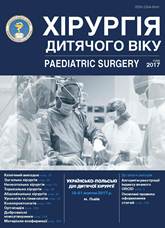Long-gap esophageal atresia. torakoskopy or toracotomy?
DOI:
https://doi.org/10.15574/PS.2017.56.38Keywords:
newborn, long-gap esophageal atresia, thoracoscopy, Foker procedureAbstract
Esophageal atresia is a сongenital malformation, in which the continuity of the esophagus is impaired and there are two segments that are not interconnected. Each of segments may end blind pouches or with a fistula that attached to the tracheobronchial tree. Newborns with this defect need surgical treatment. Survival of children with esophageal atresia is currently 95–98%. Failures happen if the baby was born much before a term and has the combined malformations, and/or pneumonia. Besides, the long-gap esophageal atresia is considered to be a particularly difficult clinical case. To solve this problem, various methods are proposed. Foker’s procedure has been used successfully. The procedure for elongation can be performed both with thoracotomic and thoracoscopic access.Objective. To analyze treatment outcomes in children with long-gap esophageal atresia (LGEA).
Material and methods. In the clinic of pediatric surgery of the Tyumen State Medical University 9 Foker procedures were performed. Four of which were made using the thoracoscopic access. In one patient both stages were managed to carry out mini-invasively.
Results. Thoracoscopic elongation of esophagus did not increase the number of early and late postoperative complications.
Conclusions. World experience shows that thoracoscopic surgeries have better long-term results. The surgeon’s task is to ensure saving of the patient’s own esophagus, even in case of LGEA. This task helps to be solved the procedure of elongation by J. Foker. Our experience shows that using the method of Foker Wulf, you can not only save the esophagus without damaging its tissue, but also to conduct as a primary operation (the external or internal traction sutures are placed), as well as to form the esophago-esophagoanastomosis thoracoscopically.
References
Akselrov MA, Emelyanova VA, Malchevskiy VA et al. (2017). Atreziya pischevoda s «nepreodolimyim diastazom». Aktualnyie voprosyi detskoy hirurgii. Materialyi VIII Respublikanskoy nauchno-prakticheskoy konferentsii s mezhdunarodnyim uchastiem. Gomel: 24–26.
Akselrov MA, Emelyanova VA, Suprunets SN et al. (2017). Uspeshnoe primenenie torakoskopii (elongatsiya po Fokeru i formirovanie otsrochennogo anastomoza) u rebenka s mnozhestvennyimi porokami razvitiya, odin iz kotoryih atreziya pischevoda s nepreodolimyim diastazom. Meditsinskiy vestnik Severnogo Kavkaza. 12; 2: 138–141.
Akselrov MA, Ivanov VV, Alekseenko SS et al. (2012). Shkala otsenki i monitoringa pereoperatsionnogo perioda u novorozhdennyih detey / // Navigator v mire nauki i obrazovaniya. 4–7(20–23): 555.
Akselrov MA, Kolmagorova ON, Chernyishev AK. (2012). Kompyuternaya shkala otsenki tyazhesti sostoyaniya i operatsionnogo riska u novorozhdennyih detey. Navigator v mire nauki i obrazovaniya. 4–7(20–23): 553.
Akselrov MA, Saharov SP, Sergienko TV et al. (2016). Torakoskopicheskaya elongatsiya pischevoda po Fokeru pri atrezii s nepreodolimyim diastazom. Fundamentalnyie i prikladnyie problemyi zdorovesberezheniya cheloveka na severe. Materialyi Vserossiyskoy nauchno-prakticheskoy konferentsii. Surgut: 275–278.
Akselrov MA, Sergienko TV, Emelyanova VA et al. (2016). Torakoskopiya pri atrezii pischevoda s nepreodolimyim diastazom. Chelovek i lekarstvo. Ural – 2016. Materialyi kongressa. Tyumen, RITs «Ayveks»: 10.
Akselrov MA, Sergienko TV, Kostryigin SV et al. (2015). Metod Fokera pri atrezii pischevoda s nepreodolimyim diastazom. Pervyiy opyit primeneniya torakoskopii (klinicheskoe nablyudenie). Rossiyskiy vestnik detskoy hirurgii, anesteziologii i reanimatologii. Pril: 21.
Atreziya pischevoda. Pod red YuA Kozlova, VV Podkameneva, VA Novozhilova. (2015). Moskva, GEOTAR-Media: 125–134.
Grinevich YuM, Averin VI, Govoruhina OA et al. (2015). Atreziya pischevoda v respublike Belarus. Sostoyanie problemyi po rezultatam lecheniya za 2008–2014 gg. Hirurgiya Vostochnaya Evropa. 3(15): 18–22.
Kiseleva NV, Suprunets SN, Anohina IG et al. (2006). Klinicheskiy sluchay sochetannyih porokov razvitiya u novorozhdennogo rebenka (atreziya pischevoda, tetrada Fallo, edinstvennaya pochka). Meditsinskaya nauka i obrazovanie Urala. 7; 5: 65–67.
Kovalchuk VI, Novosad VV. (2015). Lechenie atrezii pischevoda s bolshim diastazom mezhdu ego segmentami. Hirurgiya Vostochnaya Evropa. 3(15): 23–27.
Kovalchuk VI, Novosad VV. (2010). Sravnitelnaya otsenka rezultatov operativnogo lecheniya atrezii pischevoda. Novosti hirurgii. 18; 3: 97–102.
Kozlov YuA, Yurkov PS, Novozhilov VA et al. (2005). Atreziya pischevoda – torakoskopicheskoe nalozhenie anastomoza. Detskaya hirurgiya. 3: 54–55.
Morozov DA, Haspekov DV, Topilin OG et al. (2015). Torakoskopicheski-assitirovannyie operatsii posle ekstratorakalnoy mnogoetapnoy elongatsii pischevoda po K. Kimura. Detskaya hirurgiya. 19; 3: 19–23.
Razumovskiy AYu, Mokrushina OG, Hanverdiev RA et al. (2012). Evolyutsiya metoda torakoskopicheskoy korrektsii atrezii pischevoda u novorozhdennyih. Rossiyskiy vestn detskoy hirurgii, anesteziol i reanimatol. 2; 1: 92–98.
Razumovskiy AYu, Morkushina OG. (2015). Endohirurgicheskie operatsii u novorozhdennyih. Moskva, OOO «Izdatelstvo «Meditsinskoe informatsionnoe agenstvo»: 17–37.
Foker D, Kozlov Yu. (2016). Protsedura Fokera (Foker) – strategiya induktsii rosta pischevoda putem ego vyityazheniya. Detskaya hirurgiya. 20; 2: 102–109.
Foker JE, Kendall TC, Catton K, Khan K. (2005). A flexible approach to achieve a true primary repair for all infants with esophageal atresia. Semin Pediatr Surg. 14: 8–915. https://doi.org/10.1053/j.sempedsurg.2004.10.021; PMid:15770584
Foker JE, Kendall-Krosch TC, Catton K et al. (2009). Long-gap esophageal atresia treated by growth induction: the biological potential and early follow-up results. Semin Pediatr Surg. 18: 23–9. https://doi.org/10.1053/j.sempedsurg.2008.10.005; PMid:19103418
Konkin DE, O’Hali WA, Weber EM et al. (2003). Outcomesin esophageal atresia and tracheoesophageal fistula. J Pediatr Surg. 38: 1726–1729. https://doi.org/10.1016/j.jpedsurg.2003.08.039; PMid:14666453
Lobe TE, Rothenberg SS, Waldschmidt J. (1999). Thoracoscopic repair of esophageal atresia in an infant: A surgical first. Pediatr Endosurg Innovative Tech. 3: 141–148. https://doi.org/10.1089/pei.1999.3.141
Van der Zee D. (2011). Thoracoscopic elongation of esophagus in longgap esophageal atresia. J Pediatr Gastroenterol Nutr. 52: 13–5. https://doi.org/10.1097/MPG.0b013e3182125d75; PMid:21499035
Downloads
Issue
Section
License
The policy of the Journal “PAEDIATRIC SURGERY. UKRAINE” is compatible with the vast majority of funders' of open access and self-archiving policies. The journal provides immediate open access route being convinced that everyone – not only scientists - can benefit from research results, and publishes articles exclusively under open access distribution, with a Creative Commons Attribution-Noncommercial 4.0 international license(СС BY-NC).
Authors transfer the copyright to the Journal “PAEDIATRIC SURGERY.UKRAINE” when the manuscript is accepted for publication. Authors declare that this manuscript has not been published nor is under simultaneous consideration for publication elsewhere. After publication, the articles become freely available on-line to the public.
Readers have the right to use, distribute, and reproduce articles in any medium, provided the articles and the journal are properly cited.
The use of published materials for commercial purposes is strongly prohibited.

